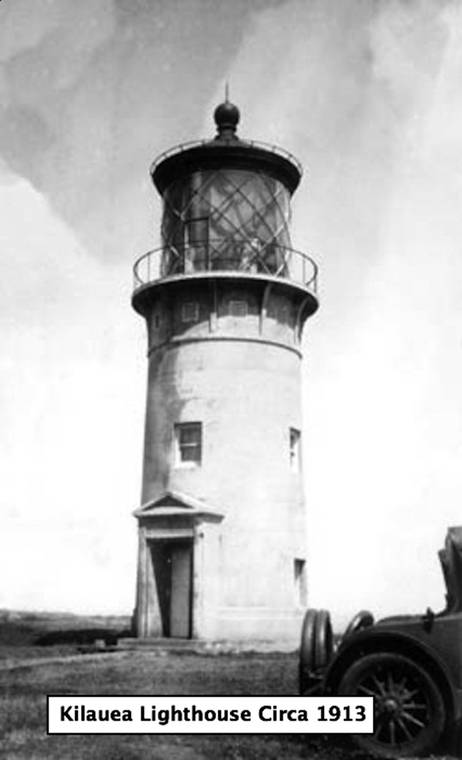On Thursday evening, May 1, 1913, Construction Superintendent Frank C. Palmer pressed a button at the newly constructed Kilauea Point Lighthouse that resulted in the illumination, for the first time, of the lighthouse’s 250,000 candle power lamp, which immediately began flashing every 10 seconds for a distance of 21 miles.
On Thursday evening, May 1, 1913, Construction Superintendent Frank C. Palmer pressed a button at the newly constructed Kilauea Point Lighthouse that resulted in the illumination, for the first time, of the lighthouse’s 250,000 candle power lamp, which immediately began flashing every 10 seconds for a distance of 21 miles.
Accompanying Palmer was Kilauea Sugar Plantation manager Jackson R. Myers and other leading citizens of Kaua‘i, while hundreds of country people from miles around gathered on hillsides and along shores to witness the lighthouse’s first gleam.
Construction of the lighthouse at 180 feet above sea level had begun in August 1912 with initial funding in the amount of $75,0000 being provided through the U. S. Congress; Kilauea Point itself had previously been purchased from Kilauea Sugar Plantation for the sum of only one dollar.
Building supplies were transported to Kilauea Point by sea aboard the lighthouse tender, “Kukui,” which would anchor offshore and dispatch lighters to a cove near the point.
The lighters would anchor to cleats cemented into rocks near a boom derrick built on a ledge that would transfer the supplies from the lighters onto a platform situated 110 feet above the ocean.
Ironwork for the 54-foot tall lighthouse’s concrete tower lantern room and spiral staircase was produced by Champion Iron Company of Kenton, Ohio; the illuminating apparatus was manufactured in Paris, France by the firm of Barbier, Bernard, and Turenne; Lighthouse Depot, Staten Island, N.Y. made the light.
Additionally, three lighthouse keeper’s houses were built on the point, with Harry W. Flint being the first head keeper.
Very simply put, the process by which the light originally operated was as follows: Three gallons of kerosene oil was put into a tank and pressurized, after which, the oil, under pressure, was conducted through tubes to a preheating lamp inside the lens, which caused the oil to become gaseous. Finally, the gas was passed through a nozzle under the mantle, where it was ignited to form light.


